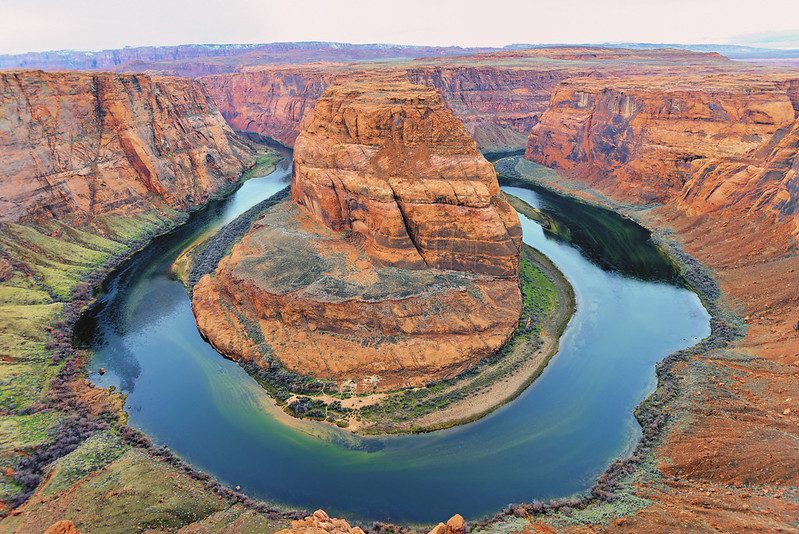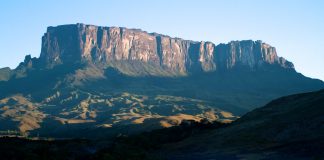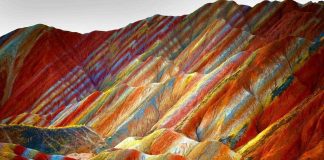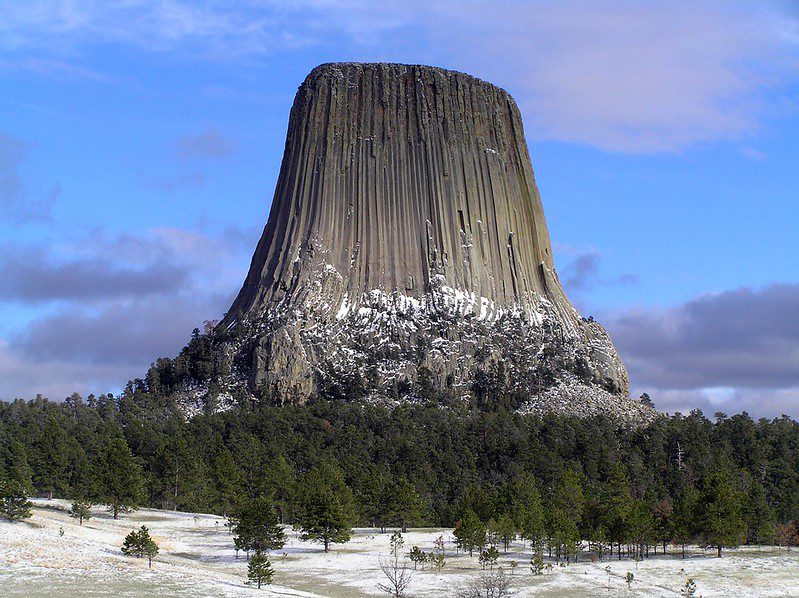
Introduction To Devils Tower National Monument
A Natural Wonder in Wyoming
The Devil’s Tower National Monument is a unique natural wonder located in the northeastern corner of Wyoming. Rising over 1,200 feet above the Belle Fourche River, this towering monolith is a sight to behold, drawing visitors from all over the world to marvel at its beauty and grandeur.
Where is the Devil’s Tower In Wyoming Located?
The Devil’s Tower is located in the northeastern part of Wyoming, in the Black Hills region. It is located in the Devil’s Tower National Monument, which is administered by the National Park Service.
The monument is situated in Crook County, in the Belle Fourche River valley, and it is about 10 miles east of the town of Hulett and about 12 miles northwest of the town of Sundance.
It is about a 4-hour drive from the city of Rapid City, South Dakota, and about a 5-hours drive from the city of Cody, Wyoming.
The monument can be accessed by car, and several roads lead to the park, including Wyoming State Highway 24 and Wyoming State Highway 110.
The Devil’s Tower sits above the Belle Fourche River, which flows through the Black Hills region of South Dakota and Wyoming. The river provides a picturesque backdrop to the monument, and its waters are a popular spot for fishing and recreation.
Devils Tower Height
The height of the Devil’s Tower is 867 feet (264.4 meters) above the Belle Fourche River. It stands as a striking geological feature in the Belle Fourche River valley, and its height makes it one of the most prominent natural landmarks in the region.
The tower is made of phonolite porphyry, a type of igneous rock, and it is composed of large hexagonal columns that are visible on its surface. Visitors can hike around the tower’s base or climb to the summit, offering a unique and breathtaking view of the surrounding area.
Why is it Called Devils Tower?
When Colonel Richard Dodge led a U.S. Geological Survey party to the massive rock formation in 1875, he coined the name “Devil’s Tower” because he believed it was a place of evil spirits. The name was derived from the local Native American legends that associated the tower with evil spirits.
The National Park Service later adopted the name, and has been called “Devils Tower” ever since. The name is also thought to have been influenced by the tower’s imposing and steep appearance, which may have seemed ominous and devilish to early visitors.
Devils Towers Is Also Known As Bear Lodge By The Native American Indians
The Devil’s Tower also got another name from an interpretive translation of the Native American name “Bear Lodge,” which was used by the local tribes. The name “Bear Lodge” is derived from the belief that bears created the tower by clawing at the rock.
The legend goes that the tower was created when seven young girls were chased by giant bears and prayed to the rock to save them. The rock then rose to save the girls, and the bears clawed the sides of the rock, creating the parallel cracks that we see today.
An Astounding Geologic Feature
The Devil’s Tower is considered an astounding geologic feature due to its unique and striking appearance. It is a steep-sided, massive, columnar-jointed igneous intrusion that rises dramatically above the surrounding terrain. The tower is made of phonolite porphyry, a type of igneous rock composed of large crystals that give the rock a distinctive texture and appearance.
Its unique columnar basalt formation results from the cooling and contraction of magma or lava. The contraction caused the rock to crack and fracture in a distinctive pattern of hexagonal columns. The parallel cracks, or joints, that run up the sides of the tower are one of its most striking features and make it an ideal spot for rock climbing.
Furthermore, the Devil’s Tower is also an important site for geologists and scientists, as it provides insight into the processes that shaped this unique landscape and the history of the Earth’s crust.
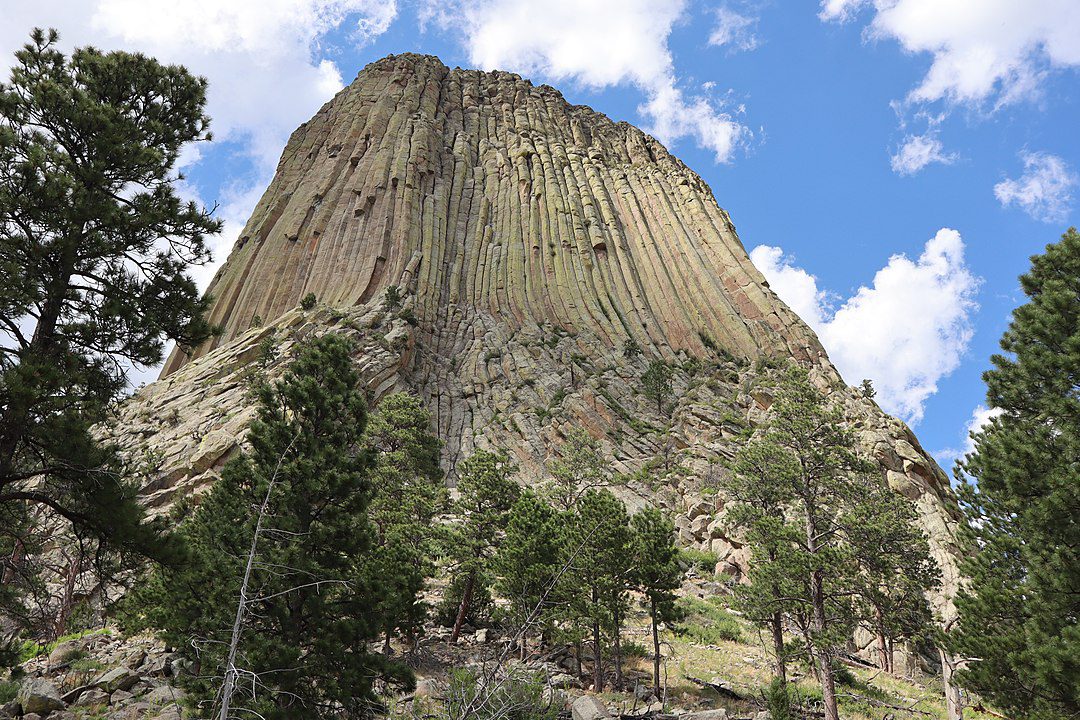
10 Unique Facts About The Devil’s Tower in Wyoming
- The Devil’s Tower is the first National Monument in the United States, designated as such in 1906 by President Theodore Roosevelt.
- The tower is made of igneous rock formed by the solidification of magma. The vertical fractures in the rock are called “joints,” and the hexagonal shape of the rock is called “columnar basalt.”
- The Devil’s Tower is sacred to several Native American tribes, who have their own myths and legends associated with it. Some tribes believe that the tower was created by giant bears, while others say lightning strikes formed it.
- The first recorded ascent of the Devil’s Tower was made in 1893 by William Rogers and Willard Ripley.
- The park service closes the climbing routes during the month of June as a way to respect the Native American ceremonies that take place at the site.
- The Devil’s Tower National Monument is home to a unique ecosystem, including rare and endangered species such as the black-footed ferret, swift fox, and the American pika.
- The monument is located in an area with minimal light pollution, making it an ideal spot for stargazing.
- The park service offers regular astronomy programs, including guided stargazing tours, telescope viewing sessions, and lectures by experts in the field.
- The Devil’s Tower has been featured in numerous films and TV shows, including the classic film Close Encounters of the Third Kind.
- The park offers a variety of recreational opportunities, including hiking, camping, rock climbing, and wildlife viewing.
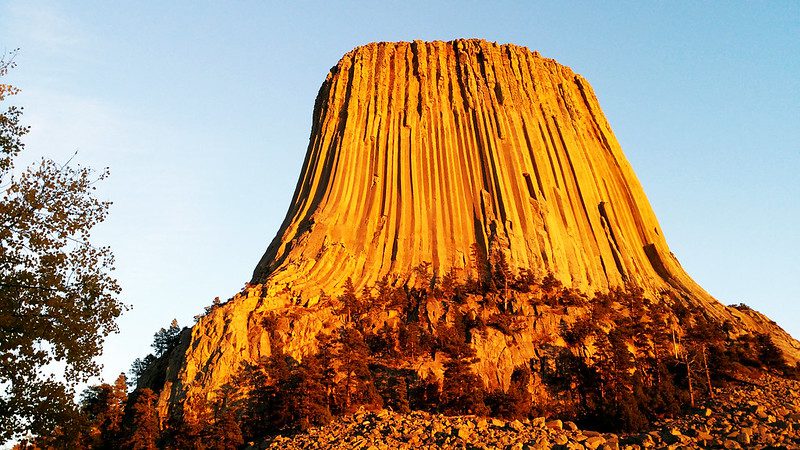
Geology
5 Geological Formations Unique to Devils Rock
- Columnar Basalt: The Devil’s Tower is an example of columnar basalt, a type of volcanic rock that forms when lava cools and solidifies. The rock at the Devil’s Tower is composed of basalt that cooled and solidified slowly, forming large, hexagonal columns that are visible on the tower’s surface. The columns are typically about 3-4 feet wide and can be as tall as 120 feet.
- Dikes: Dikes are steep, vertical, tabular, or sheet-like intrusive bodies that cut across the existing rock formations. The Devil’s Tower has many dikes visible on its surface, these dikes are formed by the intrusion of magma into the existing rock and are perpendicular to the columns.
- Joints: Joints are fractures in the rock that do not show any displacement. They are parallel to the cooling surface. The Devil’s Tower has many joints that are visible on its surface. The contraction of the rock forms them as it cools and solidifies.
- Spheroidal Weathering: Spheroidal weathering is a type of weathering that occurs when water enters joints, dikes, and fractures in the rock. The water causes the rock to expand and contract, which leads to the formation of rounded shapes on the rock’s surface. The Devil’s Tower has many examples of spheroidal weathering on its surface. These are visible as round-shaped features on the columns, dikes, and joints.
- Glacial Grooves: The Devil’s Tower is also home to glacial grooves, which are smooth, linear depressions carved into the rock by the movement of glaciers. These grooves are evidence of the last ice age and can be seen on the northern side of the tower. They were carved by the glaciers that covered the area during the last ice age.
Formation Of The Devil’s Tower From Volcanic Origins
The Devil’s Tower is made of igneous rock formed by the cooling and solidification of magma. Its volcanic origins can be traced back millions of years when molten rock pushed its way to the surface and solidified into the towering columnar basalt we see today.
Columnar Basalt Formation – A Geological Feature
The columnar basalt formation of the Devil’s Tower is one of its most striking features. As the magma cooled and solidified, it formed into columns, creating the unique hexagonal shape that is so iconic of the monument. The columns can range in size from less than an inch to over 6 feet in diameter.
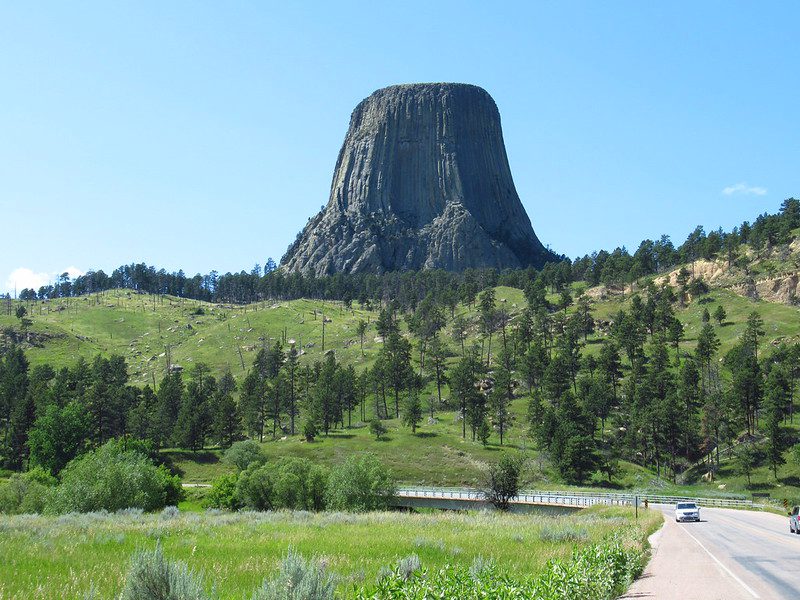
Unique Landscape Features
The geology of the Devil’s Tower has created a unique landscape that is unlike anything else in the world. The towering basalt columns rise out of the surrounding prairie, contrasting the soft grasses and the rough, jagged rock. The monument is also home to a variety of other geologic features, including rock spires, hoodoos, and fissures, making it a geologist’s paradise.
Parallel Cracks
The Devil’s Tower is known for its parallel cracks, or “fractures,” which are a defining feature of its unique geology. These parallel cracks, or joints, were formed as the tower cooled and solidified. As the outer layer of the rock cooled faster than the inner layers, it contracted and formed these parallel fractures.
These fractures give the tower its characteristic hexagonal shape, making it an ideal spot for rock climbing. The parallel cracks also make the Devil’s Tower a popular destination for geologists and geology enthusiasts.
Native Americans & Legends
Significance in Tribal Culture
The Devil’s Tower holds great significance for many Native American Indians and Tribes. The region’s indigenous people have long regarded the monument as a sacred site, and it has played an important role in their culture and traditions.
Various Interpretations and Myths
Different tribes have different interpretations of the monument, and many have their own myths and legends associated with it. Some believe the tower was created by giant bears, while others say lightning strikes formed it. Still, others see it as a place of spiritual power and pilgrimage.
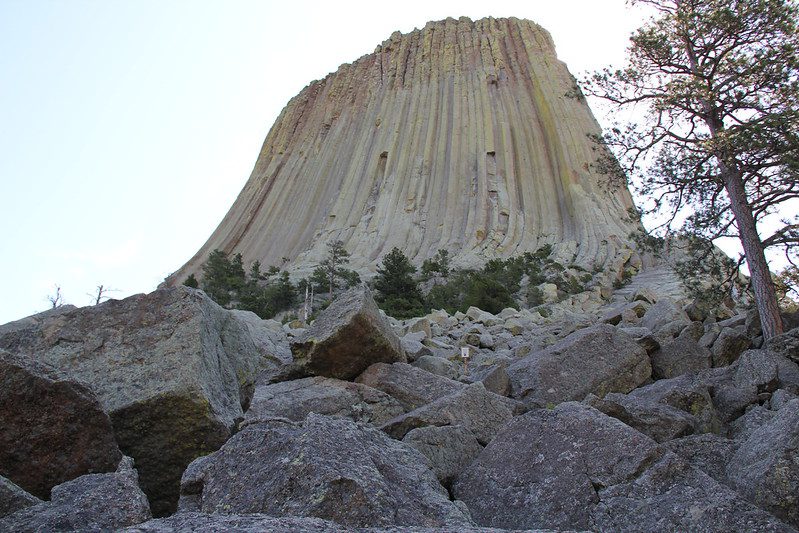
Devils Tower Myths and Legends
The Devil’s Tower has many myths and legends associated with it among different tribes, cultures, and communities. Some of the known myths and legends about the Devil’s Tower include:
- Sioux Legend: According to one Sioux legend, the tower was created when seven young girls were chased by giant bears and prayed to the rock to save them. The rock then rose to save the girls, and the bears clawed the sides of the rock, creating the parallel cracks that we see today.
- Cheyenne Legend: The Cheyenne tribe believed that the tower was a sacred place where the Thunder Beings lived and that the lightning bolts of the Thunder Beings created parallel cracks.
- Kiowa Legend: According to the Kiowa tribe, the tower was created by a giant bear who clawed at the rock to create parallel cracks.
- Arapaho Legend: The Arapaho tribe believed that the tower was created by a giant beaver who clawed at the rock to create parallel cracks.
- Hidatsa Legend: The Hidatsa tribe believed that the tower was a sacred place where their ancestors emerged from the earth and that the spirits of their ancestors created parallel cracks.
These are a few examples of the myths and legends that have been passed down through the generations about the Devil’s Tower. Each tribe has its own version and interpretation of the tower’s origins and spiritual significance. These legends and myths are considered an important part of the cultural heritage of the tribes and are still honored today.
The Sacred Site Of Bear Lodge
Bear Lodge, also known as Devil’s Tower, is a sacred site to several Native American tribes, including the Lakota Sioux and Cheyenne, and is considered a powerful place of spiritual significance.
It is considered an important place for ceremonies, vision quests, and other spiritual activities. The name Bear Lodge comes from the belief that bears, which are considered sacred animals, created the tower by clawing at the rock. This belief is reflected in the many bear paw petroglyphs that can be found on the walls of the tower.
The tower has been a popular place of pilgrimage for many generations of the Northern Plains Indians, who consider it to be a sacred site.
The park service has made efforts to respect the spiritual significance of the monument for the Northern Plains Indians by closing the climbing routes during the month of June to avoid interfering with ceremonies and rituals that take place at the tower.
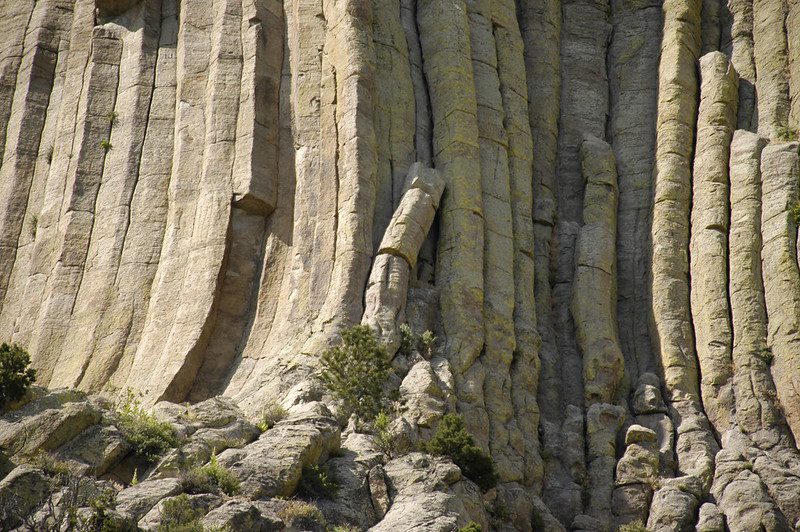
Devils Tower Native Indian Names
The Devil’s Tower has several different Native American names, depending on the tribe and language. Some of the known Native American names for the Devil’s Tower include:
- Bear Lodge: This name is used by the Lakota Sioux and Cheyenne tribes and is derived from their belief that bears created the tower by clawing at the rock. This name is also reflected in the many bear paw petroglyphs that can be found on the walls of the tower.
- Bear’s House: This name is used by the Kiowa tribe and is also derived from their belief that bears created the tower.
- Bear’s Lair: This name is used by the Arapaho tribe and is also derived from their belief that bears created the tower.
- Tree Rock: This name is used by the Crow tribe and is derived from their belief that the tower was once a tree that grew so tall it reached the sky.
- Grizzly Bear Lodge: This name is used by the Hidatsa tribe and is derived from their belief that bears created the tower.
These are a few examples of the names that the native tribes have given to the Devil’s Tower. The reason for such names is based on the tribes’ spiritual beliefs, legends, and traditions.
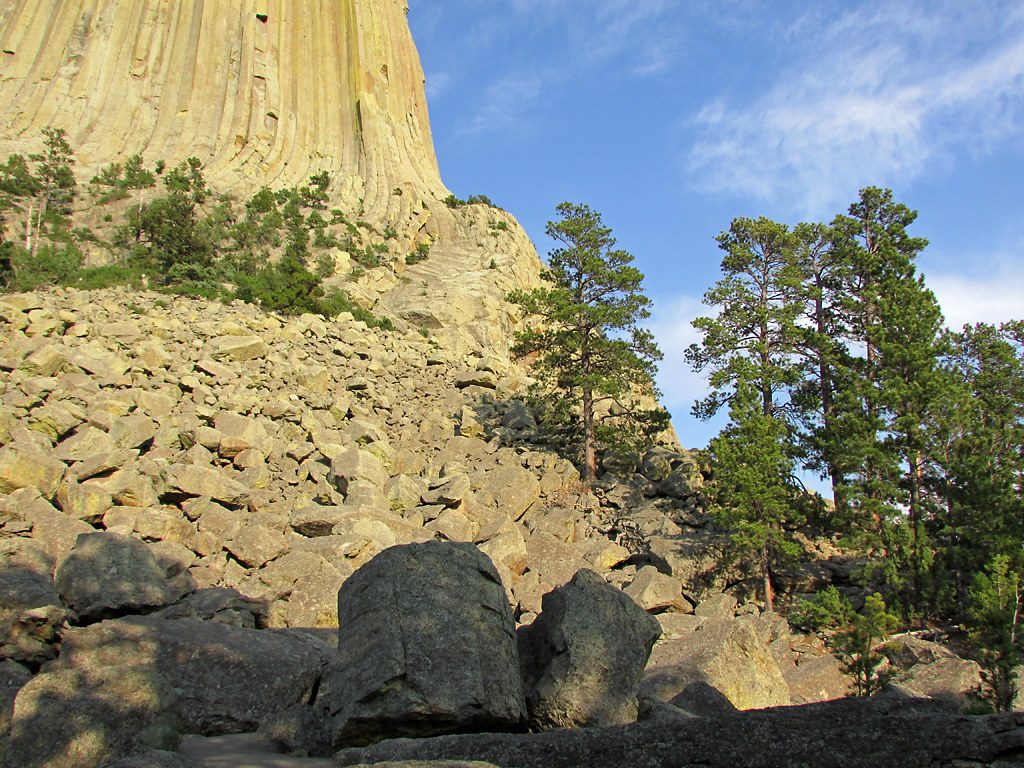
Northern Plains Indians
The Devil’s Tower has been of spiritual significance to the Northern Plains Indians for centuries. The Northern Plains Indians include tribes such as the Sioux, Cheyenne, Arapaho, and Crow. For many of these tribes, the tower is considered sacred and associated with creation stories, spiritual visions, and ceremonies.
According to one Sioux legend, the tower was created when seven young girls were chased by giant bears and prayed to the rock to save them. The rock then rose to save the girls, and the bears clawed the sides of the rock, creating the parallel cracks that we see today.
The Northern Plains Indians also have a long history of climbing the tower for recreational purposes and as a spiritual rite of passage. They believe that climbing the tower is a way to connect with the spiritual world and gain spiritual power and vision.
The park service has made efforts to respect the spiritual significance of the monument for the Northern Plains Indians by closing the climbing routes during the month of June to avoid interfering with ceremonies and rituals that take place at the tower.
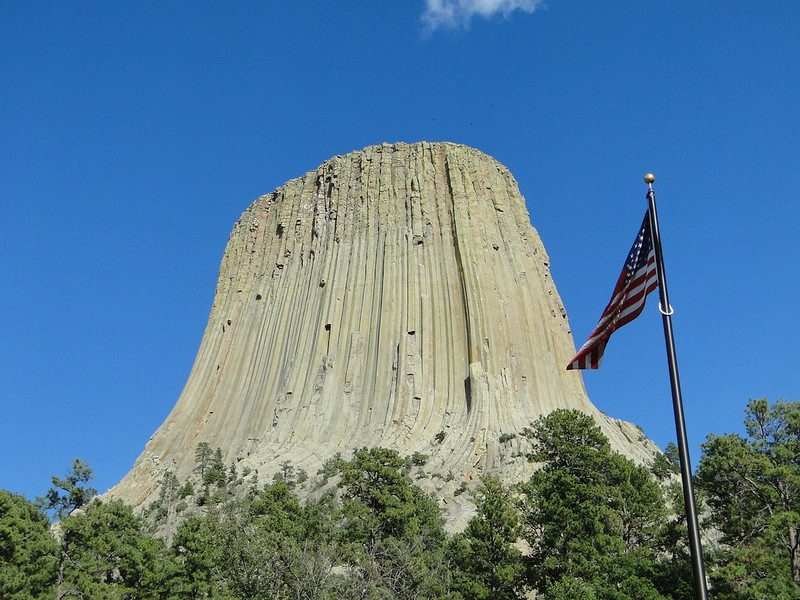
Rich History, Early Explorers and Climbers
First Documented Visitors to Devils Tower
The first known non-Native American visitors to see the tower.
The first documented visitors to the Devil’s Tower were several members of Captain W.F. Raynold’s Yellowstone Expedition who arrived in 1859. The expedition, led by Captain Raynold, was commissioned by the U.S. government to explore and survey the western territories, including the area surrounding the Devil’s Tower.
The expedition’s members were among the first non-Native American visitors to see the tower, and their accounts of the massive rock formation helped to bring it to the wider public’s attention.
Sixteen years later, in 1875, Colonel Richard Dodge led a U.S. Geological Survey party to the Devil’s Tower. The party was tasked with conducting a scientific study of the monument and its surrounding area. During the survey, Colonel Dodge coined the name “Devil’s Tower” for the massive rock formation, which is thought to have been inspired by the local Native American legends that associated the tower with evil spirits.
The survey conducted by Colonel Dodge’s party was the first scientific study of the tower and helped to establish it as a unique and significant geologic feature. The survey also helped bring the tower to the public’s attention, and it began attracting the interest of geologists, naturalists, and tourists.
In the years that followed, the tower continued to attract visitors, and it was designated as the first national monument by President Theodore Roosevelt in 1906. Today, the Devil’s Tower continues to be a popular destination for visitors and is considered one of the finest climbing areas in the world.
Geologist W.H. Holmes conducted the first scientific study of the tower in 1892, and it was designated as the first national monument by President Theodore Roosevelt in 1906. The tower has since become a popular destination for visitors and continues to attract thousands of visitors each year.
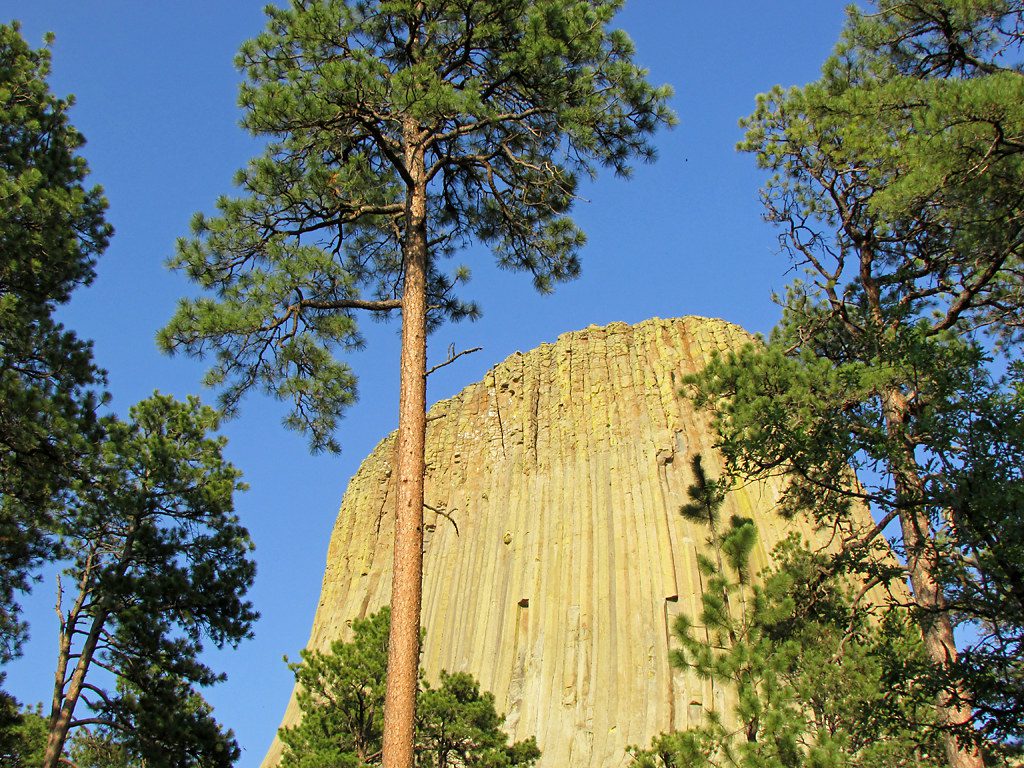
William Rogers and Willard Ripley’s Ascent in 1893
William Rogers and Willard Ripley’s ascent of the Devil’s Tower in 1893 was a significant event in the monument’s history. They were the first known people to climb the tower, and their ascent marked the beginning of the tower’s rise in popularity as a climbing destination.
In the summer of 1893, William Rogers, a rancher, and Willard Ripley, a photographer, set out to climb the tower. They used a combination of natural features and homemade wooden pegs to ascend the tower.
The climb was not easy, and they encountered several obstacles, such as loose rock, difficult terrain, and steep pitches, but they finally reached the summit on July 4, 1893.
Their ascent was not without controversy, as some Native American tribes considered the tower a sacred site and were opposed to climbing it. Nevertheless, their climb sparked interest in the tower, and it began to attract climbers from around the country.
Their ascent also encouraged others to climb the tower, and in the years that followed, more and more people began to climb the tower, and it became a popular destination for climbers.
Today, the climb is a challenging and technical one and requires proper equipment, experience, and training. The park service has implemented rules and regulations to ensure climbers’ safety and protect the monument’s natural and cultural resources.
Read About Rogers & Ripley Stake Ladder – Devils Tower
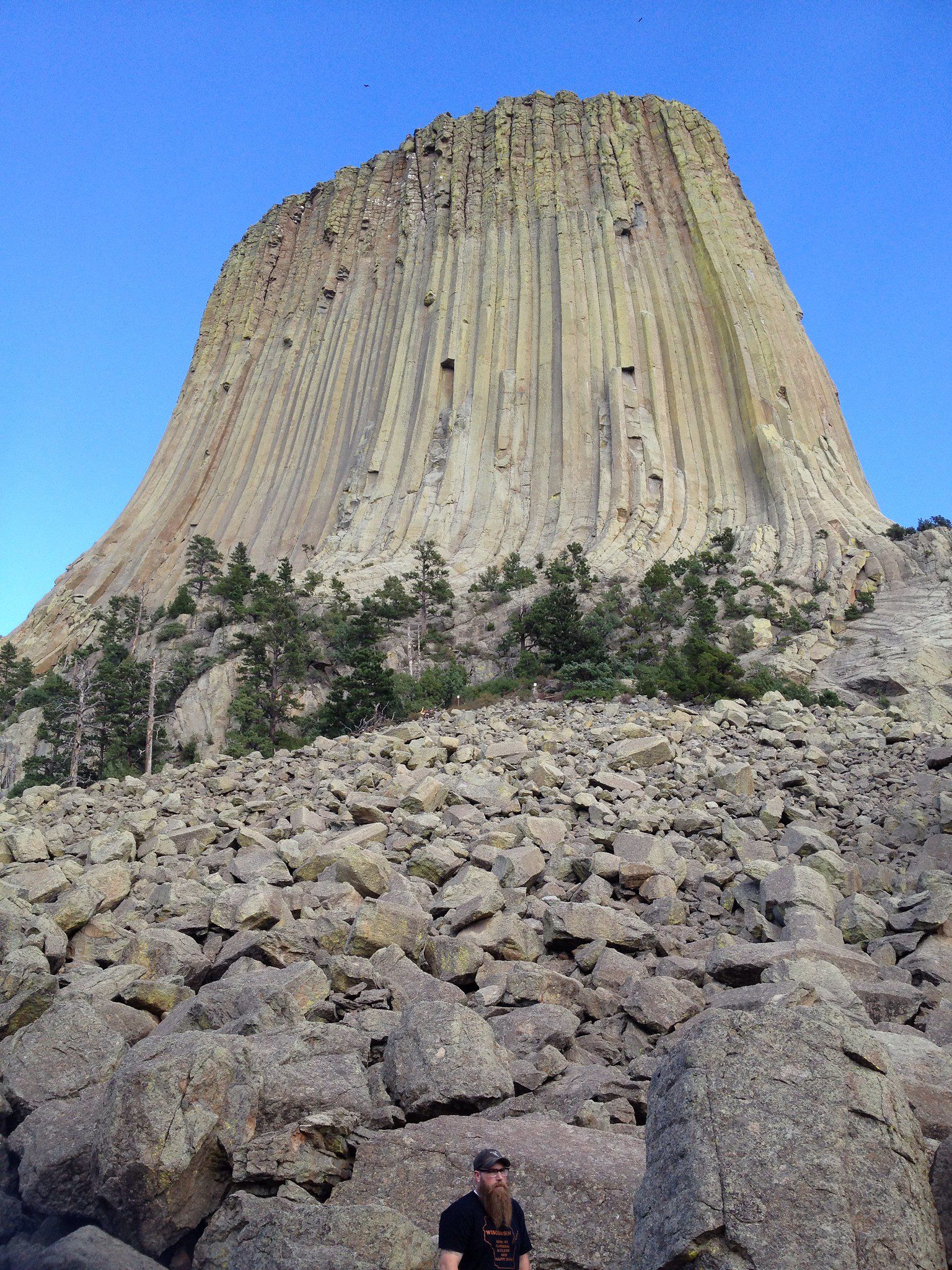
Evolution and History
The history of climbing at the Devil’s Tower is fascinating, from the first ascent to the development of new techniques and the increasing popularity of the monument as a climbing destination. Climbers have been coming to the Devil’s Tower for over a century, and it has become one of the most iconic climbing destinations in the world.
A Historical Timeline of the Devil’s Tower
- Millions of years ago: Volcanic activity in the area results in the formation of the igneous rock that makes up the Devil’s Tower.
- Pre-European contact: Native American tribes in the region have long regarded the monument as a sacred site, and it played an important role in their culture and traditions.
- Late 19th century: William Rogers and Willard Ripley made the first recorded ascent of the Devil’s Tower in 1893.
- 1906: President Theodore Roosevelt designated the Devil’s Tower as the first National Monument in the United States.
- The 1920s-1930s: The Civilian Conservation Corps (CCC) developed trails and built the first road to the monument, making it more accessible to visitors.
- The 1950s: Climbing at the Devil’s Tower became increasingly popular with new techniques and routes.
- The 1970s: Climbing routes are closed during the month of June as a way to respect the Native American ceremonies that take place at the site.
- The 1980s: A reintroduction program is launched to reintroduce the endangered black-footed ferret to the area.
- The 1990s: The park service began offering regular astronomy programs, including guided stargazing tours, telescope viewing sessions, and lectures by experts in the field.
- 21st century: The Devil’s Tower continues to draw visitors from all over the world and remains an important cultural, historical and natural site in the United States.
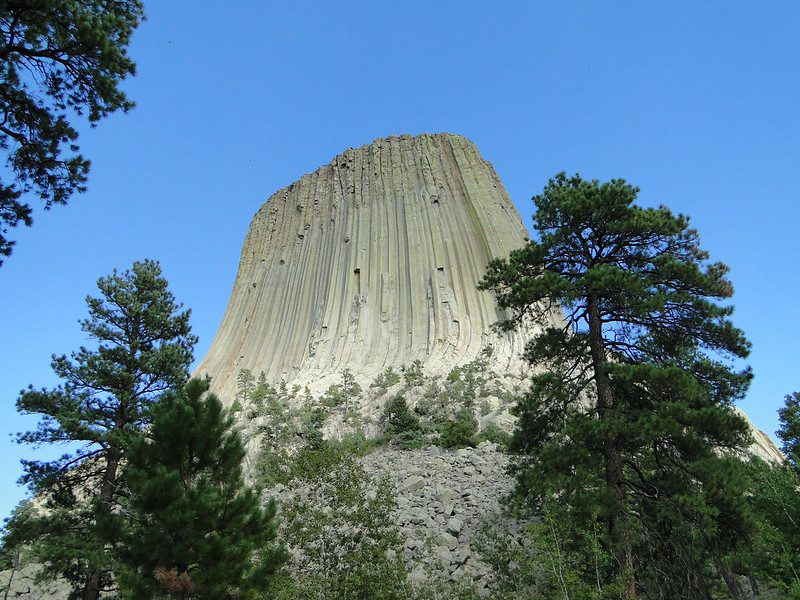
Rise in Popularity as a Climbing Destination
The Devil’s Tower has become increasingly popular as a climbing destination over the years. The combination of its unique geology and the challenge it presents to climbers has made it a magnet for rock climbers worldwide.
Modern Rock Climbing of The Devil’s Tower In Wyoming
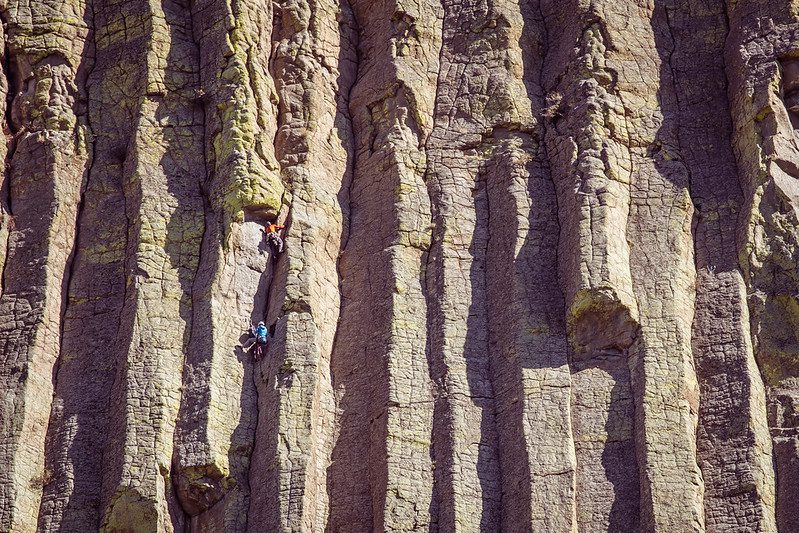
Technical Challenges
Climbing the Devil’s Tower is a challenging and technical endeavor. The routes up the monument are steep and challenging, with a mix of vertical cracks, overhangs, and ledges. The rock is also known for being slippery, and it can be difficult to find secure hand and foot holds.
Routes and Difficulty Levels
There are over 100 climbing routes up the Devil’s Tower, ranging in difficulty from easy to extremely difficult. Some of the most popular routes include the Durrance Route, the Red Garden Wall, and the Belle Fourche Buttress.
10 Most Popular Climbing Routes Of the Devils Tower
- Durrance Route: This route is considered the most popular climbing route on the Devil’s Tower and is known for its sustained difficulty. The route is a five-pitch climb and has a grade of 5.7.
- Red Garden Wall: This is another classic route on the Devil’s Tower and is known for its aesthetic and challenging climbing. The route is a four-pitch climb and has a grade of 5.9.
- Belle Fourche Buttress: This route is known for its steep and challenging climbing and is a favorite among experienced climbers. The route is a five-pitch climb and has a grade of 5.11.
- Rat Race: This route is considered one of the most challenging routes on the Devil’s Tower and is known for its steep and sustained climbing. The route is a five-pitch climb and has a grade of 5.12.
- The El Matador: This route is a long and sustained climb and is known for its challenging and exposed climbing. The route is a six-pitch climb and has a grade of 5.11. It’s a very popular route among climbers.
- The Painted Face: This route is known for its beautiful and aesthetic climbing. The route is a four-pitch climb and has a grade of 5.8. It’s a good option for intermediate climbers looking for a challenging but not overly difficult climb.
- The Sundance Kid: This route is known for its steep and strenuous climbing. The route is a four-pitch climb and has a grade of 5.10. It’s a popular choice among climbers looking for a physically demanding climb.
- The Gendarme: This route is considered one of the most iconic routes on the Devil’s Tower and is known for its challenging and exposed climbing. The route is a four-pitch climb and has a grade of 5.10. It’s a must-do for experienced climbers visiting the Devil’s Tower.
- The Kor-Ingalls Route: This route is considered one of the most classic routes on the Devil’s Tower and is known for its sustained and challenging climbing. The route is a six-pitch climb and has a grade of 5.9. It’s a popular choice among climbers visiting the Devil’s Tower for the first time.
- The Upper Exum Route: This route is known for its beautiful and scenic climbing. The route is a five-pitch climb and has a grade of 5.8. It’s a great option for intermediate climbers looking for a more relaxed climb with great views.
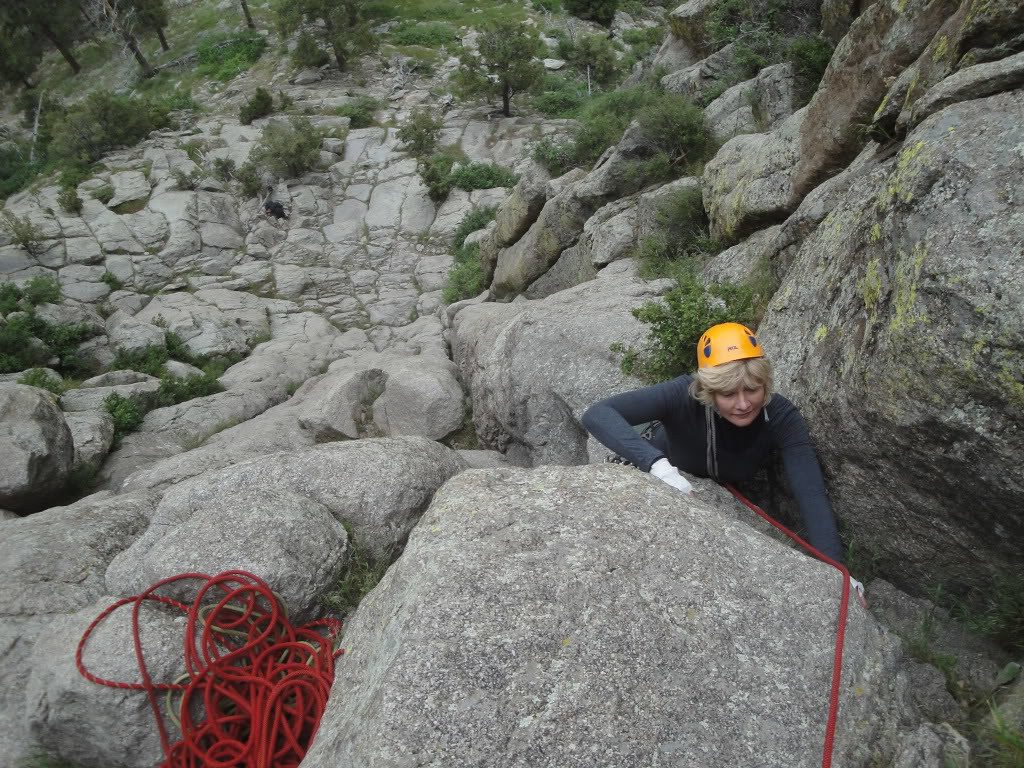
One Of The Best Crack Climbing Areas In The World
The Devil’s Tower is considered one of the finest crack climbing areas in the world and is renowned among climbers for its unique and challenging routes. The tower’s parallel cracks, or joints, that run up the sides of the tower offer a wide range of climbing opportunities for climbers of all skill levels.
The tower’s crack climbing routes are divided into two main categories: traditional climbing and sport climbing. Traditional climbing routes involve placing removable protection into the cracks as a way to secure the rope. On the other hand, sports climbing routes already have permanent anchors and protection.
Some of the most popular sport climbing routes at the Devil’s Tower include:
- Solar Exposure: A single-pitch route that offers challenging climbing and is considered one of the best routes on the tower.
- Dracula: A single-pitch route that offers challenging climbing and is considered one of the most popular routes on the tower.
- The Last Dinosaur: A single-pitch route that offers challenging climbing and is considered one of the most difficult routes on the tower.
The Devil’s Tower is also a popular spot for bouldering, which is climbing short routes without the use of ropes or harnesses, and top-rope climbing, which is a type of climbing where the rope is anchored at the top of the climb.
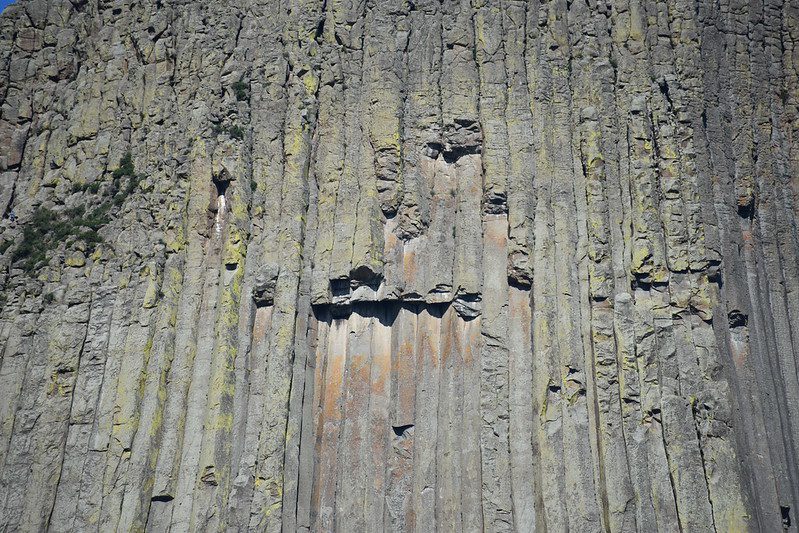
Safety Measures
Climbing the Devil’s Tower is not without its risks, and safety measures are in place to protect both climbers and visitors. Climbers are required to register at the park’s visitor center before climbing, and certain routes may be closed during certain times of the year to protect nesting raptors. Climbing is also not allowed during the month of June as a way to respect the Native American ceremonies that take place at the site.
Wildlife and Flora
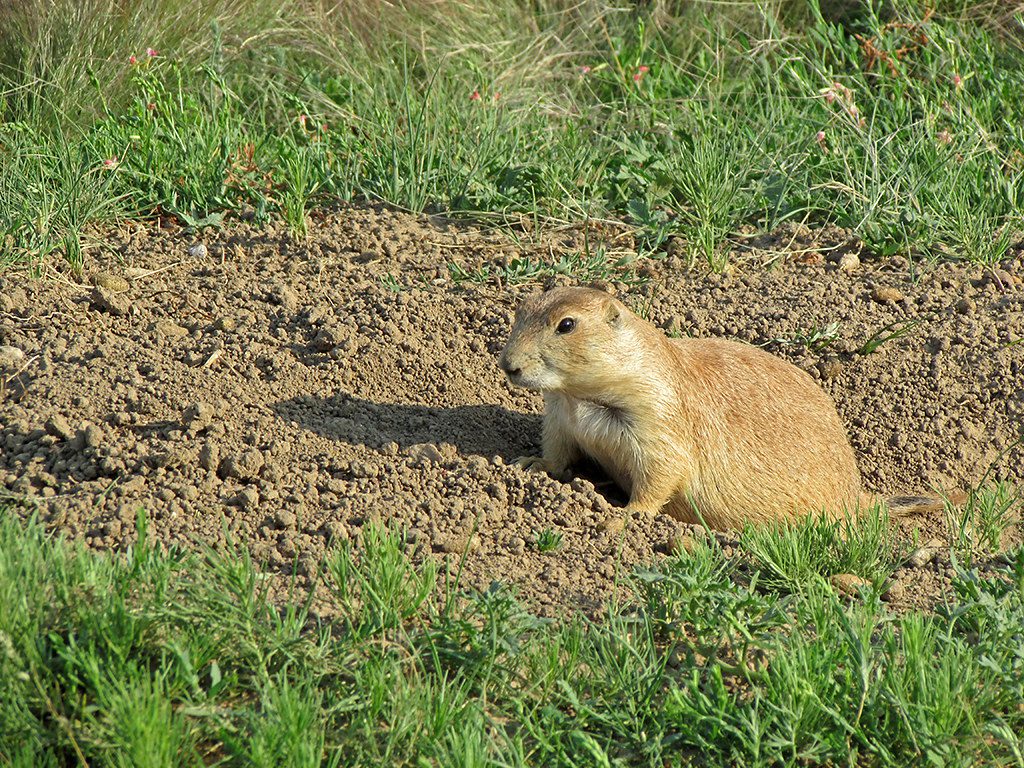
10 Wildlife and Flora that can be found at Devils Tower
- Pronghorn: The pronghorn is a type of ungulate that is native to the Great Plains and can be found in the Devil’s Tower National Monument. They are known for their speed and endurance and are considered to be the fastest land mammal in North America.
- Bison: The bison, also known as the American buffalo, is a large mammal that is native to North America and can be found in the Devil’s Tower National Monument. They are known for their shaggy coats and humped shoulders and are an important symbol of the American West.
- Mule deer: The mule deer is a type of deer that is native to North America and can be found in the Devil’s Tower National Monument. They are known for their large ears and long legs and are an important prey species for predators such as mountain lions and coyotes.
- Prairie dog: The prairie dog is a type of rodent that is native to the Great Plains and can be found in the Devil’s Tower National Monument. They are known for their social behavior and burrowing habits and play an important role in the ecosystem as a food source for predators such as hawks and badgers.
- Golden eagle: The golden eagle is a large bird of prey that is native to North America and can be found in the Devil’s Tower National Monument. They are known for their powerful talons and sharp beak and are an important predator in the ecosystem.
- Sagebrush: Sagebrush is a type of shrub that is native to the Great Plains and can be found in the Devil’s Tower National Monument. It is a drought-tolerant plant that is important for wildlife and livestock grazing.
- Indian paintbrush: Indian paintbrush is a type of wildflower that is native to the Great Plains and can be found in the Devil’s Tower National Monument. It is known for its bright red and orange color and is a popular flower among visitors.
- Pinyon pine: The Pinyon pine is a species of pine that is native to the western United States and can be found in the Devil’s Tower National Monument. They are known for their small size and distinctive cones and are an important food source for wildlife such as birds and small mammals.
- Western juniper: The Western juniper is a species of juniper that is native to the western United States and can be found in the Devil’s Tower National Monument. They are known for their ability to survive in arid environments and are an important component of the ecosystem, providing shelter and food for wildlife.
- Wild rose: The wild rose is a type of rose that is native to North America and can be found in the Devil’s Tower National Monument. It is known for its beautiful flowers and is an important source of nectar for pollinators such as bees and butterflies.
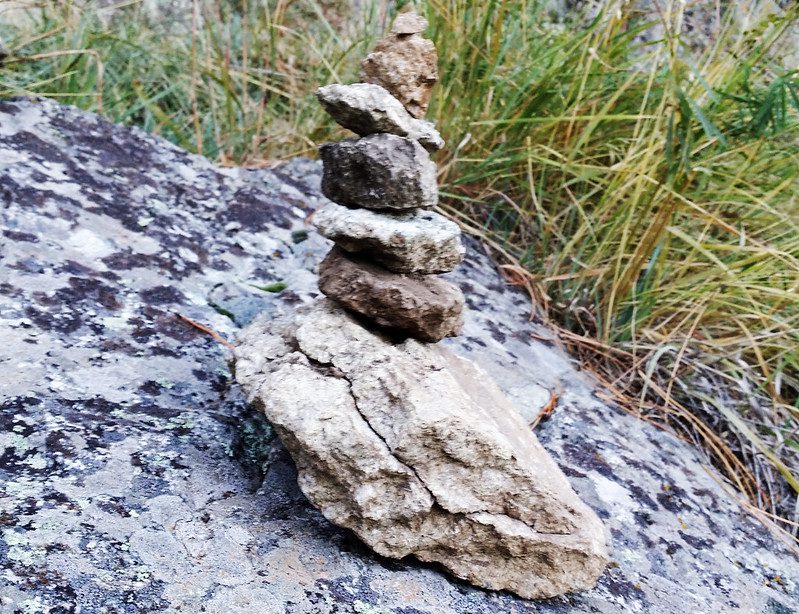
Unique Ecosystem at the Devils Tower
The Devil’s Tower is home to a unique ecosystem that is shaped by its geology and location. The monument is surrounded by prairie grasslands, which support a variety of plants and animals. The rocky outcroppings of the monument provide a habitat for rare and endangered species, including the black-footed ferret, swift fox, and the American pika.
Endangered Species That Live Near The Devils Tower
The Devil’s Tower is home to several endangered species, including the black-footed ferret and swift fox. Conservation efforts have been put in place to protect these species, including reintroduction programs and habitat restoration projects.
Conservation Efforts
The National Park Service and other organizations work to protect and preserve the unique ecosystem of the Devil’s Tower. Conservation efforts include:
- Habitat restoration.
- The reintroduction of endangered species.
- The management of invasive species.
Astronomy
Dark Skies and Stargazing Opportunities At Devils Tower In Wyoming
The Devil’s Tower is located in an area with minimal light pollution, making it an ideal spot for stargazing. On clear nights, visitors can see an incredible array of stars and celestial bodies, including planets, galaxies, and nebulas.
Astronomy Programs and Events
The park service offers regular astronomy programs, including guided stargazing tours, telescope viewing sessions, and lectures by experts in the field. These programs allow visitors to learn more about the night sky and the science of astronomy.
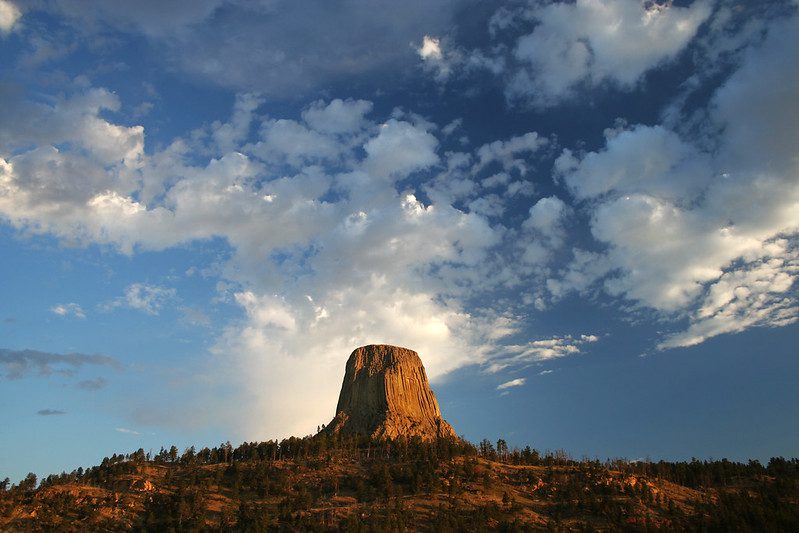
5 Astronomy Programs and Events At The Devils Tower
- Starry Night Programs: The park service offers regular stargazing programs, where visitors can explore the night sky with the help of park rangers and astronomers. These programs include telescope viewing sessions, guided stargazing tours, and lectures by experts in the field.
- Astronomy Weekends: The park service hosts regular astronomy weekends, where visitors can take part in a variety of astronomy-related activities, such as telescope viewing, star-gazing, and lectures by experts.
- Dark Sky Festival: The park service hosts an annual Dark Sky Festival that features a variety of astronomy-related activities and events, including telescope viewing, stargazing, and lectures by experts.
- Solar Viewing: The park service allows visitors to view solar events, such as solar eclipses and sunspots, through special telescopes equipped with solar filters.
- Night Sky Photography Workshops: The park service offers workshops for visitors interested in learning how to photograph the night sky. These workshops are led by professional photographers and include instructions on how to take stunning night sky photos with different types of cameras.
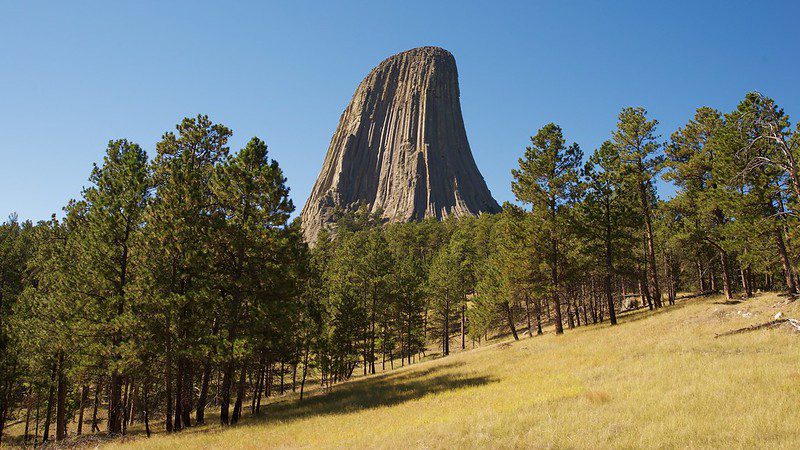
Cultural Significance
National Monument Designation in 1906
President Theodore Roosevelt designated the Devil’s Tower as the first national monument in the United States in 1906. This designation recognizes the monument’s significant natural, cultural, and historical values.
Role in American History and Film
The Devil’s Tower has played an important role in American history and culture. It has been featured in numerous films and TV shows, including the classic film Close Encounters of the Third Kind.
5 TV Shows Or Movies The Devils Tower Has Been Featured In
- Close Encounters of the Third Kind: This iconic 1977 science fiction film, directed by Steven Spielberg, features the Devil’s Tower as the location of a close encounter between humans and extraterrestrial beings.
- Into the Wild: This 2007 film directed by Sean Penn is based on the true story of Christopher McCandless, who journeyed to the Devil’s Tower as part of his travels across North America.
- Longmire: This crime drama television series, which ran for six seasons from 2012 to 2017, featured the Devil’s Tower in several episodes as the location of crimes and investigations.
- Westworld: This science fiction television series, which premiered in 2016, featured the Devil’s Tower in the background of several episodes as a symbol of the park’s western-themed narrative.
- The Lone Ranger: This 2013 film, directed by Gore Verbinski, featured the Devil’s Tower in the background of several scenes as a symbol of the wild west.
The Devils Tower Visitor Information
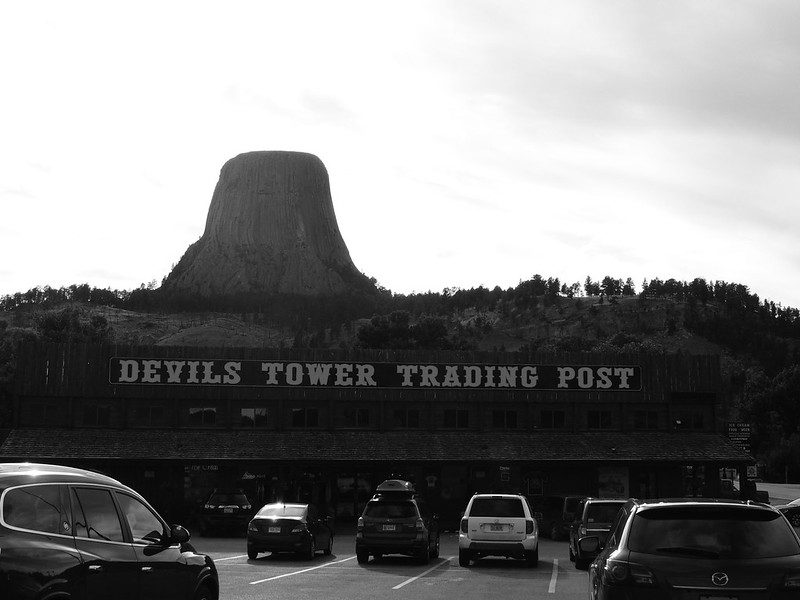
Park Hours and Entrance Fees
The Devils Tower National Monument is open year-round, but hours vary depending on the season. There is a fee to enter the park, and annual passes are also available.
Amenities and Services: The park offers a variety of amenities and services to visitors, including a visitor center, picnic areas, restrooms, and a campground. There is also a gift shop on site, where visitors can purchase souvenirs and books about the park.
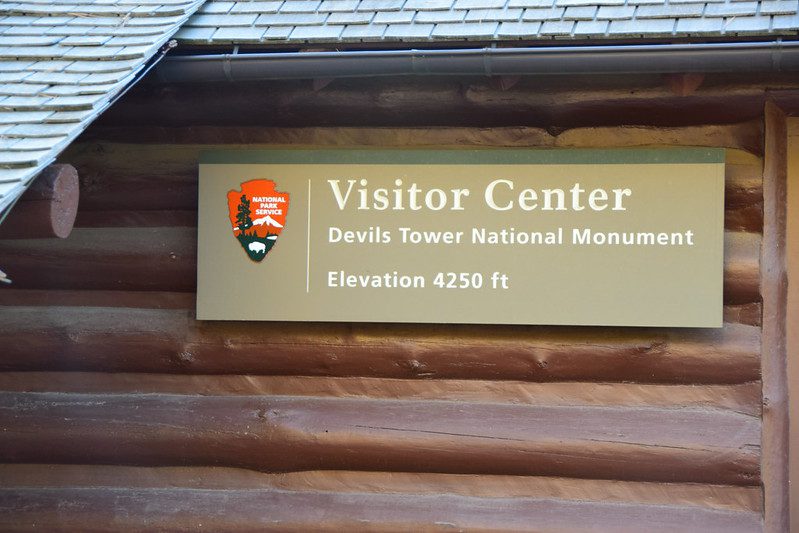
Accessibility
The park offers accessible features for visitors with disabilities, including designated parking spaces, wheelchair-accessible restrooms, and a designated accessible campsite.
5 Ways To Get To The Devils Tower In Wyoming
- By Car: The Devil’s Tower National Monument is located in northeastern Wyoming and can be easily accessed by car. Visitors can take highway 24 from the town of Sundance, and the monument is well-signposted.
- By Shuttle Bus: The park service offers a shuttle bus service that runs from the visitor center to the base of the Devil’s Tower during the peak season.
- By Bicycle: The park service offers a bike rack at the visitor center, and visitors can ride to the base of the Devil’s Tower on the park’s scenic road.
- By Hiking: Visitors can also hike to the base of the Devil’s Tower on the park’s designated trails. The Tower Trail is 1.3 miles long, and the Red Beds Trail is 1.5 miles long.
- By Air: The nearest airport to the Devil’s Tower is the Rapid City Regional Airport, which is about 75 miles away. Visitors can rent a car or take a shuttle bus from the airport to the monument.
6 Nearby Attractions To The Devils Tower In Wyoming
Belle Fourche River
The Belle Fourche River, which runs near the park, offers visitors the opportunity to fish, swim, and boat. The river is also a popular spot for kayaking and rafting, and several outfitters in the area offer guided trips.
Black Hills National Forest
The Devil’s Tower is located in the Black Hills National Forest, which offers a wide range of recreational opportunities, including hiking, camping, and sightseeing. The forest is home to many other natural and cultural wonders, including Mount Rushmore and the Crazy Horse Memorial.
Custer State Park
Located just a short drive from the Devil’s Tower, Custer State Park offers visitors the chance to explore 71,000 acres of rugged terrain, including granite spires, rolling hills, and picturesque valleys. Visitors can enjoy hiking, camping, fishing, and wildlife viewing, including the park’s famous bison herd.
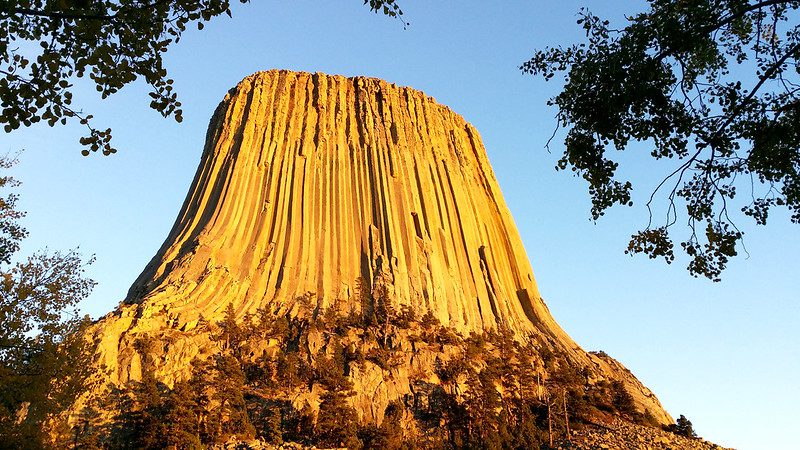
Badlands National Park
Located about 120 miles south of the Devil’s Tower, the Badlands National Park offers visitors the chance to explore one of the most unique and beautiful landscapes in the country. The park features layered rock formations, deep canyons, and a diverse array of wildlife. Visitors can hike, camp, and explore the park’s many scenic drives.
Sturgis Motorcycle Rally
Held annually in the nearby town of Sturgis, the Sturgis Motorcycle Rally is one of the largest and most famous motorcycle events in the world. Visitors can enjoy live music, motorcycle races, and the chance to see thousands of bikers from all over the world.
Other Natural and Cultural Sites
The surrounding area of the Devil’s Tower is rich in history, culture, and natural beauty. Visitors can explore the nearby Badlands National Park, the historic town of Sundance, and the beautiful Spearfish Canyon.
Accommodation, Hotels, and Motels Near Devils Tower In Wyoming
Camping and RV Parks
The Devils Tower National Monument has a campground that offers visitors the opportunity to camp in the park. There are also several RV parks located nearby that cater to visitors who prefer this type of accommodation.
Devils Tower Campground
The Devils Tower National Monument camp offers visitors the opportunity to camp in the park. It provides amenities such as flush toilets, drinking water, and picnic tables. Visitors can reserve campsites in advance, and the campground is open from May to September.
Belle Fourche River Campground
This campground is located near the Belle Fourche River and offers visitors the opportunity to camp in a beautiful and secluded setting. Amenities include vault toilets, picnic tables, and fire rings. Visitors can reserve campsites in advance, and the campground is open year-round.
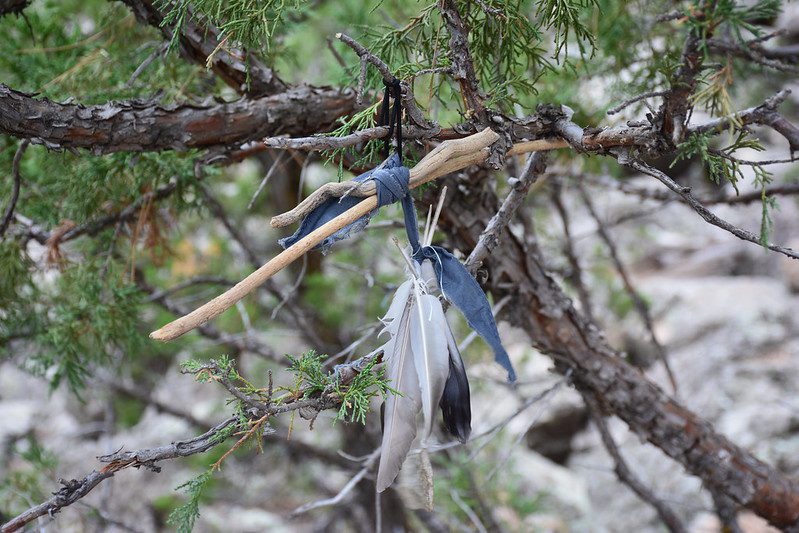
Red Lodge RV Park
This RV park is located nearby the Devil’s Tower and offers visitors the opportunity to camp in the comfort of their own RV. Amenities include full hookups, laundry facilities, and a playground. Visitors can reserve spots in advance, and the campground is open year-round.
Hotels and Lodges
Several hotels and lodges are located near the park, catering to visitors who prefer more comfortable accommodation. These options range from budget-friendly motels to luxurious resorts.
Devils Tower Lodge
This lodge is located just a short distance from the Devils Tower National Monument and offers visitors comfortable accommodations in a beautiful and secluded setting. Amenities include an on-site restaurant, an indoor swimming pool, and a hot tub. Visitors can make reservations in advance.
Belle Fourche River Lodge
This lodge is located near the Belle Fourche River and offers visitors comfortable accommodations in a beautiful and peaceful setting. Amenities include a restaurant, an outdoor hot tub, and a fire pit. Visitors can make reservations in advance.
Vacation Rentals
Visitors also have the option to stay in a vacation rental such as a cabin or a cottage. These rentals offer visitors the comfort and privacy of a home away from home.
Belle Fourche River Retreat
These vacation rentals are located near the Belle Fourche River and offer visitors the opportunity to relax and unwind in a beautiful, secluded setting. Amenities include fully-equipped kitchens, private decks, and hot tubs. Visitors can make reservations in advance.
Black Hills Vacation Homes
These vacation rentals are located in the town of Sundance and offer visitors comfortable and convenient accommodations. Amenities include fully-equipped kitchens, private decks, and hot tubs. Visitors can make reservations in advance.
The Devils Tower – A Must-See Destination for Nature and Adventure Lovers
The Devil’s Tower is a must-see destination for nature and adventure lovers, offering visitors the opportunity to explore a unique and awe-inspiring natural wonder.
From its volcanic origins to its rich cultural history to the many recreational opportunities it offers, the Devil’s Tower is a destination that is sure to leave a lasting impression on all who visit.
Whether you’re an avid rock climber, a nature enthusiast, or simply looking for a unique vacation experience, the Devils Tower is a destination that should not be missed.
Frequently Asked Questions
What’s At The Base Of The Tower?
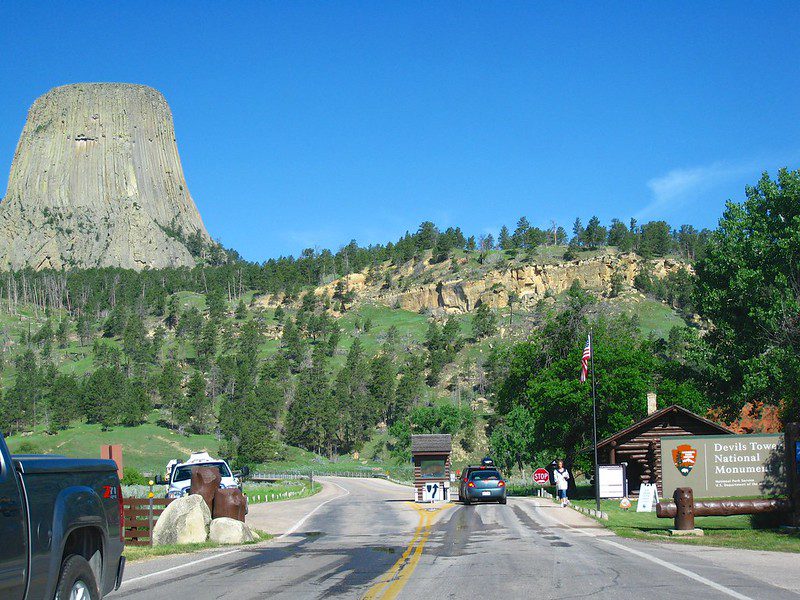
At the base of the Devil’s Tower, visitors can find a variety of amenities and services. These include:
- Visitor center: The visitor center is located at the base of the tower and provides visitors with information about the monument’s history, geology, and recreational opportunities.
- Restrooms: Restrooms are located at the tower’s base for visitors to use.
- Picnic area: There is a picnic area located at the base of the tower where visitors can enjoy a meal while taking in the views of the monument.
- Gift shop: There is a gift shop located at the base of the tower where visitors can purchase souvenirs and gifts.
- Ranger-led programs: The park service offers a variety of ranger-led programs, including guided tours of the monument, talks about its history and geology, and stargazing programs.
- Hiking trails: Several hiking trails are located at the base of the tower that leads to the summit and offers visitors the chance to explore the monument’s unique geology and wildlife.
- Climbing routes: The Devil’s Tower is a popular spot for rock climbing, and there are several climbing routes located at the base of the tower that ranges in difficulty from beginner to expert.
Online Resources
National Park Service website for the Devil’s Tower National Monument: This website has a wealth of information about the monument, including its history, geology, recreational opportunities, and visitor services. Visitors can find information about park hours, fees, directions, and details about the park’s facilities, such as the visitor center and campground. This website also provides information about upcoming events, ranger-led programs, alerts, and closures.
Devils Tower National Monument | Black Hills & Badlands: A comprehensive resource for visitors planning to visit the Devil’s Tower National Monument in Wyoming. The website provides information about the monument’s history, geology, cultural significance, and details about recreational opportunities, visitor services, and upcoming events.
The website offers a wealth of information about the monument, including details about the park’s hours, fees, and directions, as well as information about the park’s facilities, such as the visitor center and campground. The website also provides information about the park’s recreational opportunities, including hiking, rock climbing, and wildlife viewing.
The website also provides a wealth of information about the monument’s cultural significance, including the native tribes that have lived in the area for centuries, their spiritual beliefs, and legends about the tower. It also gives information about the tower’s role in American history and its designation as the nation’s first national monument in 1906.
The website also features an events calendar, providing information about upcoming events such as ranger-led programs and guided tours. The website also provides information about nearby attractions, accommodations, and restaurants, making it an excellent resource for planning a visit to the Devil’s Tower National Monument.







































